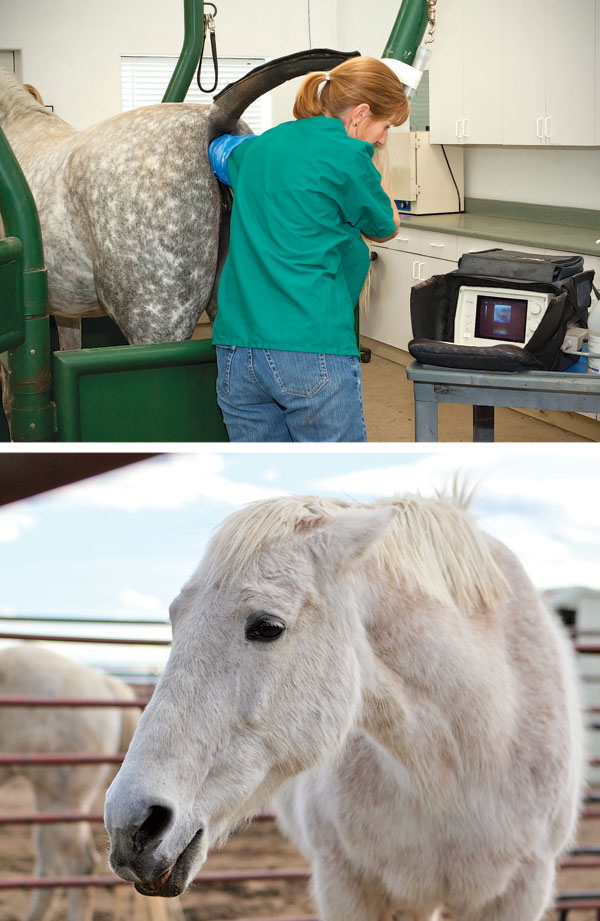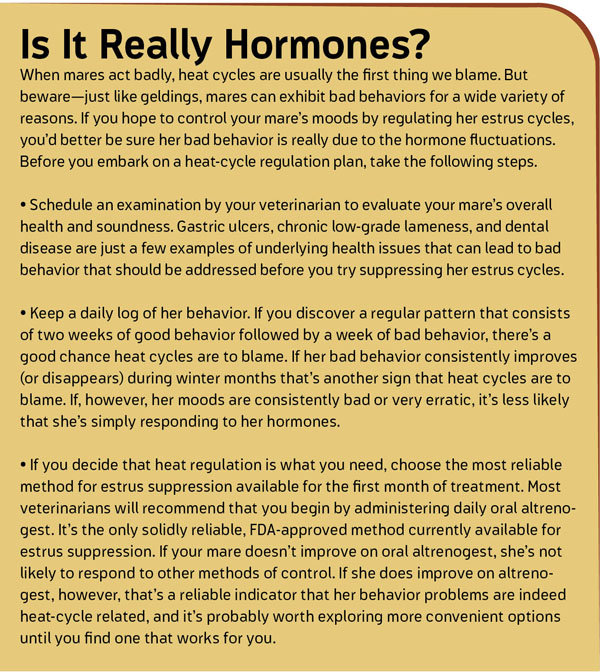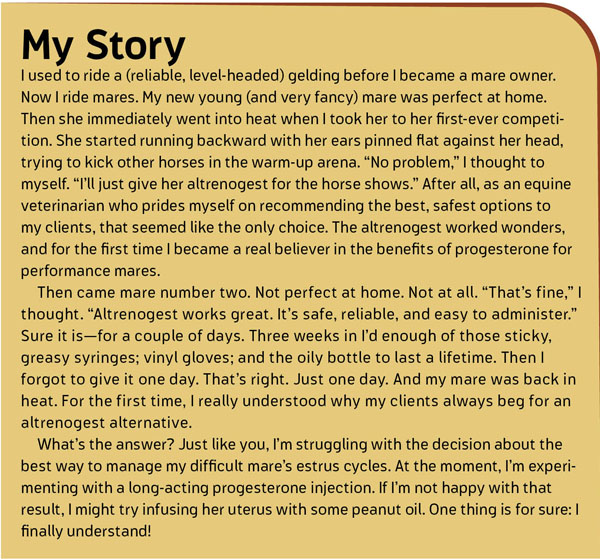There’s nothing like a good mare. She’s honest, loyal, and hard-working. She nickers when you (and only you) walk through the barn door. She has more grit than any gelding—and a certain “something special” that’s impossible to explain.
“Really?!” you might exclaim. “Exactly what mare are you talking about? Because it’s sure not mine!”
Some days, your mare is perfect. Others she’s pinning her ears, swishing her tail, and kicking at her neighbor. Sometimes she flat refuses to work. “There’s nothing like a mare all right,” you might think. But complicated, difficult, and frustrating are most often the words you use to describe her.
If you have a difficult mare, there’s a good chance raging hormones contribute to her moods. Her bad behaviors probably surface when she’s in heat. Because of this, your trainer and vet (and all of your friends) are likely to suggest controlling her heat cycle. Sound like a good idea? Of course! Unfortunately, it’s not as simple as it sounds.
In this article, I’ll teach you about your mare’s heat cycles and how her hormones can impact her moods. Once you understand exactly what you’re trying to control, I’ll explain the different estrus-management strategies available and why some options are safer and more effective than others.
[READ: Regulate Your Mare’s Cycle]
HER ESTROUS CYCLE
Your mare is seasonally polyestrus, meaning that she experiences heat cycles for a portion of the year, usually during spring and summer months. Although some mares will cycle year-round, most shut down for several months during winter—a period referred to as anestrus. Hours of daylight stimulate her reproductive cycles, so when days are longer, she’ll begin to cycle. When they’re short, she shuts down.

TOP: For many heat-cycle management practices, you’ll need to work closely with your vet to determine where your mare is in her cycle. BOTTOM: Before embarking on a heat-management program, be sure that your mare’s “bad behaviors” or “bad attitude” are caused by hormones and not other health problems.
Light sends a message to your mare’s pineal gland in her brain, which results in the release of gonadotropin-releasing hormone (GnRH) from the hypothalamus (another brain-associated gland). GnRH then stimulates the pituitary gland to release two hormones that control her estrus cycles: follicle stimulating hormone (FSH) and luteinizing hormone (LH).
As the days lengthen and activate this chain of hormonal events, FSH and LH are released in a cyclic fashion. These two hormones influence the development of follicles on her ovaries, ovulation (release of an egg) from these follicles, and the development of the corpora lutea (CL) in place of the ovulated follicle.
Increase in Estrogen
The developing follicles release estrogen, the hormone responsible for your mare’s “heat behavior.” The rise in estrogen discontinues just prior to ovulation, and when the CL forms, it releases progesterone—the “happy hormone.” Progesterone helps maintain a pregnancy in its early stages if your mare is bred. If she isn’t bred, she’ll stay out of heat until the CL lyses and the cycle begins again. On average, your mare will be “in heat” (estrus) and under the influence of estrogen for six days. She’ll be out of heat (diestrus) and under the influence of progesterone for 15 days.
Because the increase in estrogen accompanies the development of follicles, it makes sense that its impact on your mare’s behavior is to attract a stallion. Unfortunately, these stallion-attracting behaviors—frequent urination, squealing, tail swishing, and threatening other horses—are the ones that hamper her trainability and performance. Estrogen also results in muscle relaxation, so it’s possible that subtle lameness issues become more uncomfortable for her when muscular support is lacking, and she might be more at risk for soft-tissue strains (sore back, anyone?). Finally, your mare can become quite uncomfortable as follicles develop—to the point of showing full-blown colic symptoms during ovulation.
[READ: Do You Know Horse Gender Facts]
GAINING CONTROL
In short, your goal is to maximize the influence of progesterone and minimize the influence of estrogen. Ideally, the method you choose will be safe, reliable, cost-effective, and reversible (in case you decide to breed your mare). Control methods fall into three distinct categories that influence her cycle in three different ways. Here’s a rundown of strategies and options, including how they work, pros, and cons.

Strategy #1: Administer progesterone
Progesterone suppresses LH, the hormone that stimulates ovulation. Although your mare may still develop follicles that produce estrogen, progesterone combined with estrogen will still be effective at suppressing LH and turn her cycles off.
Option #1:
Daily oral administration of altrenogest (a synthetic progesterone) in oil. Historically only available as Regumate, this is the only FDA-approved treatment for estrus suppression in mares. Oral altrenogest is no longer under patent, and is now available from several different manufacturers. You can opt to administer it daily year-round or, if you mare’s behavior settles during winter anestrus, you can discontinue administration during this time of year when your mare is unlikely to be cycling anyway. Finally, if you only need to suppress your mare’s heat cycles occasionally—say, for an important competition or event—you can consider starting medications three to five days prior to the start of the event, and discontinuing when it’s over. The disadvantage to this approach is that your mare is likely to have a heat cycle soon after you stop administering the medication.
Pros: Altrenogest is the safest, most reliable means of suppressing your mare’s estrus cycles. Most vets agree it’s the best (if not the most convenient) choice.
Cons: This oil-based medication can be messy to administer—particularly on a daily basis. It poses a danger to handlers because it can be absorbed through the skin and can have an impact on hormones and menstrual cycles in women. Non-porous gloves (plastic or vinyl are best) must be worn during handling. At a cost of around $100 a month, it can also be expensive.
Recommended?: Yes.
Option #2:
Injectable progesterone. These injections are produced by a variety of compounding pharmacies and are given at intervals ranging from once a week to every 30 days. Like oral altrenogest, you can choose to administer injectable progesterone preparations year-round, or only during the time of year when your mare is likely to be cycling.
Pro: These preparations are much more convenient to administer than daily oral altrenogest.
Cons: There’s no FDA-approved form of injectable progesterone for horses, meaning there’s no regulation regarding efficacy, safety, or manufacturing conditions. Studies have shown that some of these injectable preparations are completely ineffective for suppressing estrus, including one of the most popular options, medroxyprogesterone acetate (marketed as Depo-Provera in humans). Others, including long-acting injections of altrenogest, have been shown to be effective in some mares. Injections-site reactions are not uncommon. If you opt to use an injectable progesterone, research options carefully, be sure to ask your vet for advice, and be prepared to take the risk of side effects.
Recommended?: Maybe.
Option #3:
Progesterone implants deposited under the skin. These implants are designed to help maximize weight gain and improve feed efficiency in cattle. A veterinarian usually implants eight pellets under the mare’s skin in an effort to suppress estrus.
Pros: None.
Cons: These implants don’t contain enough progesterone to suppress estrus. They are ineffective and can be dangerous.
Recommended?: Never.
Strategy #2: Create a persistent CL
After your mare ovulates, the CL that forms on her ovary produces progesterone for a period of time. Until it regresses and another heat cycle begins. Another strategy for regulating heat cycles is to manipulate your mare’s system to prolong the CL’s life.

Option #1:
Infuse her uterus with plant oils. By putting a very small volume of a sterile plant oil into your mare’s uterus on day 10 following ovulation, your vet can prolong the life of the CL and delay a return to heat. This treatment worked in 92 percent of mares in one recent study and can suppress estrus for 60 days or more. It’s still not clear exactly how this technique works, and further research is needed.
Pros: Plant-oil infusion seems to be reliably effective, is simple to perform, and appears to have no negative impact on the uterus.
Cons: To be effective, the plant oil must be infused on a specific day following ovulation—meaning your vet will have to monitor your mare’s heat cycles via ultrasound a number of times when she’s in heat to determine when she ovulates. The length of time your mare will stay out of heat is variable and unpredictable. If you will be attending an important competition or event a month or more following the infusion, you might be wise to administer oral altrenogest before and during that event to avoid the possibility that she’ll come back in heat at an inconvenient time.
Recommended?: Worth a try.
Option #2:
Administer oxytocin. Daily injections of this medication on days seven through 14 following ovulation will prolong the CL’s life. Researchers are working on protocols that don’t require specific timing post-ovulation for injection, but require daily injections for a period of several weeks. Stay tuned for updates about this technique as it becomes more widely used and studied.
Pros: This treatment is inexpensive and safe. It’s effective in up to 70 percent of mares, and can keep her out of heat for as long as 90 days.
Cons: Similar to infusing plant oils, the current protocol requires that your vet monitor your mare’s heat cycles to determine the day of ovulation before initiating treatment. If your horse is needle-shy, daily injections may be difficult to administer. It’s also difficult to predict exactly how long the CL will last, meaning your mare could come back in heat at an inconvenient time.
Recommended?: Worth a try.
Option #3:
Place a marble in her uterus. A sterilized glass marble placed into your mare’s uterus can trick her ovaries into thinking she’s pregnant. The CL on her ovary sticks around and continues to produce progesterone. If you plan to breed her in the future, your vet can remove the marble, and she’ll come back in heat.
Pros: This technique is inexpensive and easy to perform.
Cons: Removing the marble is not as easy as it sounds, and there have been reports of marbles breaking apart, damaging the uterus. This technique is only effective in about 40 percent of mares.
Recommended?: Not anymore.
Strategy #3: Shut down GnRH
By blocking the effects of GnRH, the entire hormonal cascade that causes your mare to cycle will be shut down.
Option #1:
GnRH vaccine. A vaccination stimulates your mare to produce antibodies that will block GnRh. Initially, a series of two injections is required, with annual boosters recommended to keep your mare from cycling.
Pros: The GnRH vaccine is very effective, and requires only one injection every year. It’s the most convenient of all available options.
Cons: The vaccine isn’t available in the United States, so is very difficult to obtain and very expensive. It’s possible that vaccination will shut down your mare’s estrus cycles forever (especially if she’s young), so isn’t recommended if you ever plan to breed her.
Recommended?: If you can find it and don’t plan to breed your mare.
If this all sounds overwhelming, you’re not alone. So why not just remove her ovaries and call it good? You may be surprised to learn that ovariectomy is not always effective for controlling your mare’s moods. Estrogens are still released from her adrenal glands in small amounts, and that combined with a complete lack of progesterone means your ovariectomized mare can still show signs of heat.






